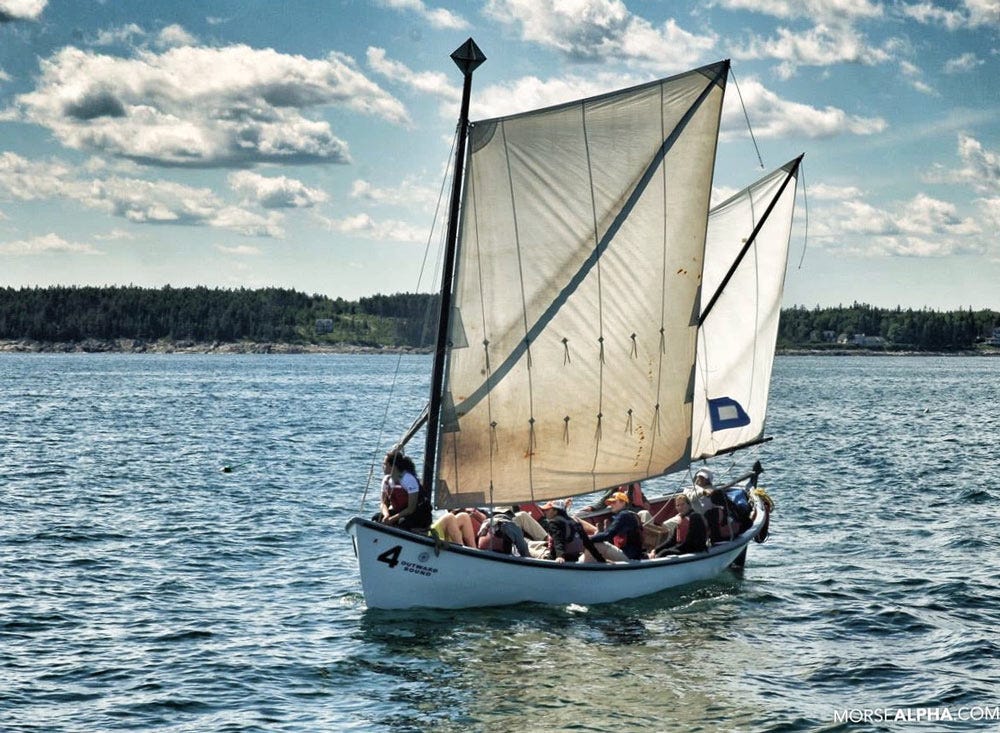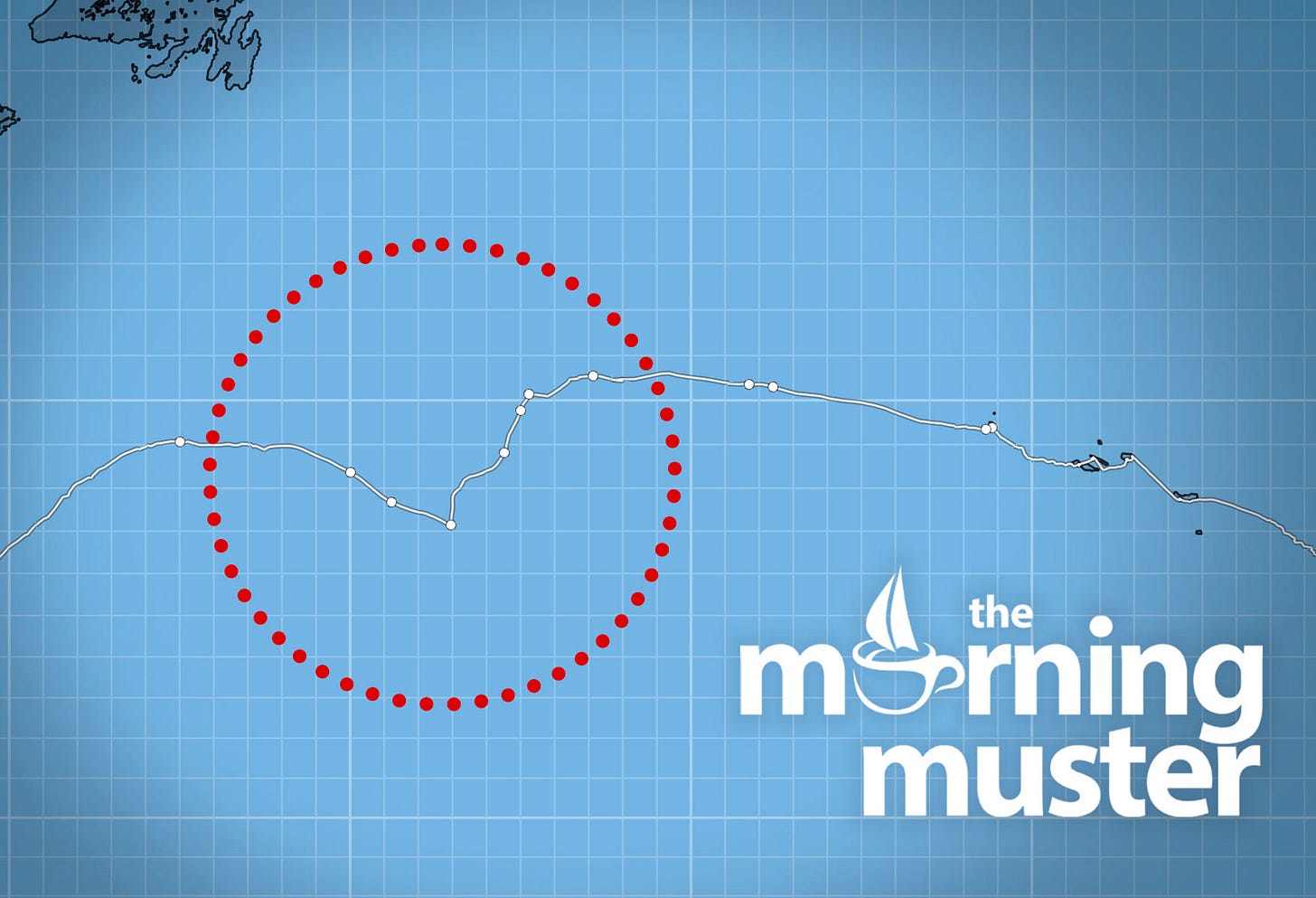Four resolution realizations that accelerated my sailing progress
The Sailing Roundup 23 • January 13, 2025
Over a decade ago, I was working for Outward Bound, a sailing program for teens and adults, where the boats were as unique as the experience itself: funny, tiny, and primitively open rowboats that doubled as our homes. Living and working aboard those stripped-down vessels was a raw and humbling experience—no electronics, no creature comforts (not even a cabin), just the sea, the sky, and your ingenuity. The cruising grounds were as challenging as the boats, testing both our physical endurance and our seamanship. It was often uncomfortable, but it was also some of the greatest skill-building of my life.
In each course, we set new goals for ourselves as instructors. One colleague wanted to master a running fix. Another set their sights on navigating upwind in thick fog with only dead reckoning. Others aspired to teach a challenging lesson they had never done before. These goals pushed us to build our confidence and capabilities incrementally.
By the time I’d been with Outward Bound for nearly a decade, I’d worked through almost every sailing skill goal I could imagine except one: learning to predict the weather. It was a skill I deeply admired in seasoned sailors, their ability to read the clouds, feel the wind shift, and anticipate what was coming next.
I tried to approach the goal systematically, breaking it into manageable steps.
Step one: Take weather notes every morning and afternoon—just observe.
Step two: Start writing morning predictions and compare them with my afternoon notes.
It seemed so straightforward. Yet, on every course, I would simply “forget” to do it. My love for teaching, navigating, and managing the group always seemed to edge out my weather project.
On one of my last courses, my course director asked me what my goal was for the trip. I told her, again, about my weather plans. She gave me a thoughtful look and said something that stuck:
“You’ve had that goal for several courses in a row now, and you haven’t followed through. What makes you think this time will be different if you approach it the exact same way? Sometimes, when a goal isn’t working, it’s not about trying harder—it’s about trying differently. Maybe it’s time to rethink how you’re tackling this or even set it aside for now.”
Her words hit me hard, but they were exactly what I needed to hear. I realized I’d been stuck in a loop, assuming that repeating the same plan would somehow lead to success. In hindsight, my repeated attempts and failures weren’t wasted. They taught me a critical lesson about goal setting: ambition alone isn’t enough. Goals need structure, and when something isn’t working, it’s okay—even necessary—to reevaluate and adapt.
I didn’t become a master weather predictor during my time at Outward Bound, but I gained something just as valuable: a deeper understanding of how to set meaningful, achievable goals and the courage to pivot when things aren’t working. That lesson has stayed with me far beyond my time on the water.
Fast forward to today
We’re a few weeks into New Year’s Resolution Season, and the gym is crowded! But let’s be honest - it’s hard to make those resolutions stick. In fact, only 8% of people manage to keep them going longer than January! We all fall in love with the idea of change and progress, but most of us aren’t willing to endure the work or pain it takes to create our new improved reality. If your goal is to get cruising in one or two years, then you have plenty to work on – so much that it might be challenging to know where to start. What is your plan? What are you going to work on? Specifically, how are you going to work on it today?
I want to share four challenges that often impede progress towards goals and strategies to overcome them to help you get out there sailing!
Set Specific Goals
Resolutions like “sail more” or “improve my sailing skills” are vague. Goals need to be specific, measurable, and actionable. For example, “I will take 2 online classes each month until sailing season begins, and then complete a 6-day coastal sailing course by July” are clear goals with defined endpoints. Also, those courses will help you find out what skills you’ve polished and what you’re still lacking.
Set New Goals
Set a new goal instead of repeating the same habits and routines. While repetition is a good thing to help solidify skills as “second nature”, more of the same won’t help you learn new skills or challenge you in new ways. For example, If you want to become a better chef, “cooking more” won’t help if all you’re doing is microwaving frozen meals or making your favorites each week (I’m guilty of this). You need to focus on experimenting with fresh ingredients and following recipes that challenge you to grow. Quality matters just as much as quantity. Likewise, a goal of “sailing more” won’t necessarily push your boundaries. So break the routine and seek new sailing recipes to challenge yourself!
Realistic Timelines But No Clear Plan
Going from occasional weekend sails to planning a passage to the Bahamas or Caribbean is a giant leap. Rightfully so, most hopeful cruisers have a 2, 3, or even 5-year plan. While that timeline is wonderfully realistic for most, a critical step is required to get there— setting short-term goals to ensure the long-term goals are met. Trying to achieve too many goals at once is overwhelming and can cause analysis paralysis. It’s better to focus on just a few key objectives. Make a list of the cruising skills you’d like to master and give each skill or subject a score of importance that helps prioritize.
Start by building a list of skills to learn, such as traditional navigation, how to use the radar, proper anchoring techniques, diesel maintenance, wilderness/offshore medical training, etc. Then, assign them an attainable timeline, and have your partner/friend hold you accountable. If you’re working with a partner, maybe you’ll divide up some of the skills, though certainly not all. Sign up for online and in-person courses and add them to your calendar.
Also include goal-setting for saving money, downsizing, setting up remote work, renting your house, and organizing life in the right ways to easily shift into the cruising life. That’s another topic which we’ll tackle in another post.
Focus Your Sailing Opportunities on Ones That Build Skill and Streamline Productive Experience
It’s easy to let your dreaming mind wander online. With many opportunities to learn from others’ experiences via YouTube, blogs, podcasts, and social media, it’s easy to feel like you’re making progress from the comfort of your couch. I like to watch educational drumming videos, and when scrolling [insert favorite platform here], it doesn’t take long to be offered absolute rules or ultimate practice routines that will solve all your problems! But the most effective learning happens when you “get behind the kit” or, in the case of sailing, when you “get out there.” Finding opportunities to sail that push your comfort and knowledge boundaries are the most effective ways to increase your skills. Joining a yacht delivery as crew can be a valuable way to gain experience, but it might not be the most efficient education. While you will be “out there doing it,” you may not get the instruction, repetition, and debriefs that really accelerate the learning process that you would if you were to sign aboard a sail training expedition. As an important side note to joining a delivery, you should thoroughly check the delivery skipper’s (and other crew’s) background and ask for references. Likewise, request the most recent survey of the boat. Take your personal safety seriously and do your own research.
From Morse Alpha:
Our Latest Podcast Ep 31: Atlantic Crossing: West to East
Sailing across the Atlantic Ocean is a demanding undertaking! In this episode we discuss the preps and plans for a West to East crossing with two sailors, who recently made the passage. We discuss what they were thinking about before departure, the projects they did, the weather planning and routing decisions, the watch systems, maintaining morale plus managing the boat and a family of five!Bunks available For Roundtrip Training Expedition to Yarmouth NS
Join us for a new serious training adventure and learn the cruising skills: advanced sailing techniques, night navigation, weather forecasting, route planning, picking the best anchorages, etc. This will be a challenging expedition of approximately 290nm that will require 2 overnight passages.
Now, for the best of the web...
Tough Pill to Swallow
After 62 days at sea racing, Éric Bellion, the French skipper of STAND AS ONE – Altavia has withdrawn from the Vendée Globe The pin system holding the J2 forestay has given way again, a situation which in time could lead to the loss of the mast.
Is Santa Cruz Harbor Poorly Designed? Yes, It Is
After gut-wrenching video of waves peeling through Santa Cruz Small Craft Harbor during Christmas week showed boats thrashing and snapping their cleats, causing some $25 million in damage to harbor infrastructure and sinking 12 boats (including at least one liveaboard), a few readers shared their experiences of being docked inside the 1,000-plus-slip marina.
How to Have Happy Boat Kids from Marisa Evans on Women Who Sail
Women who sail is a great topic and raising kids on a sailboat can be a lot of fun too. From life jackets to home schooling and medical care while aboard, Marisa Evans joins us to discuss her life aboard her 37-foot three-cabin Jeanneau Sun Odyssey sailboat with her four children. She talks about making money working at a sail loft while living aboard
Measure DC In-rush current the easy way
Our friend Rod Collins discusses how Deep Cycle LiFePo4 battery BMS can de damaged by DC motor inrush current. This video shows how to measure it without expensive equipment.
Clarisse Crémer in the Vendée Globe - Week 9: Keeping smiling and making memories
It's not the unstable weather, the stress of threatening storms, the little repairs here and there, nor the physical glitches she talks about most often, that will ultimately remain of her long-distance sailing.
Tether Tension On A Dragging Crew Overboard
What really happens when a crew member falls overboard while tethered to the boat? We know this often results in a fatality but there were no in-depth studies to help us reduce the risk. Here's the first step in fixing that.
Just Like Airline Pilots, Boaters Should Use Checklists
Every hour of every day, many thousands of airline pilots do something that, on the face of it, seems silly. Just before landing, the flying pilot lowers the landing gear, and three bright green lights illuminate. They both see the lights, and then the non-flying pilot asks: “Landing gear down?”
Bright Ideas: Upgrade Your Boat Lighting with Energy-Efficient LEDs
Upgrading your cabin lighting can be a win-win winter project. Not only will it brighten the sailboat’s interior, but swapping incandescent lamps for LEDs can also cut DC cabin-light current consumption by 75 percent or more.
New approach to measure ocean memory: North Atlantic Ocean has nearly two decades memory, study finds
A research team has developed new approach to measure ocean memory and found that the North Atlantic Ocean has a memory of approximately one to two decades, significantly surpassing previous estimates of a few years.



